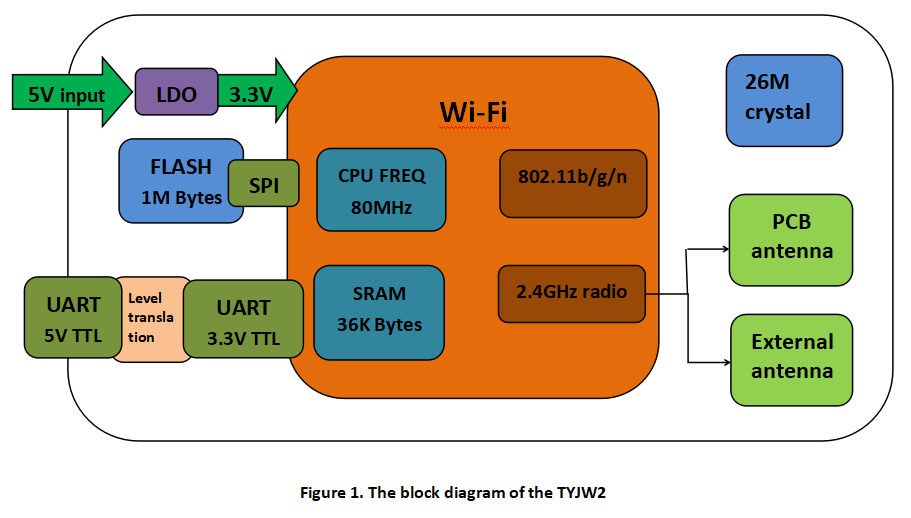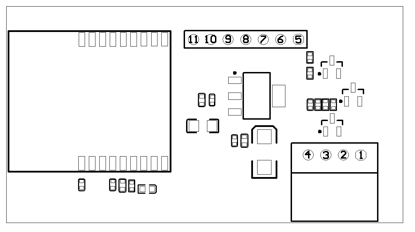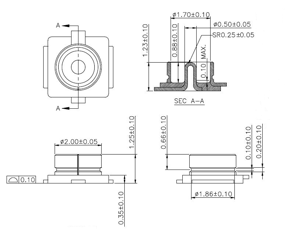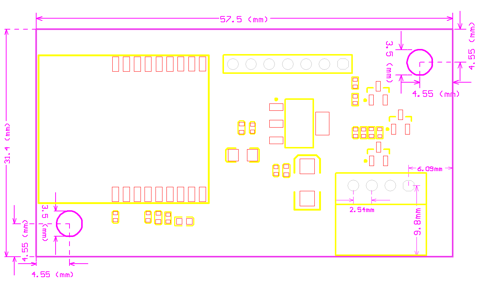Wi-Fi Module Introduction-TYJW1
Last Updated on : 2025-07-10 02:15:27download
Product Overview
TYJW1 is a Wi-Fi module developed by Hangzhou Tuya Information Technology Co., Ltd. to adapt to serial port communication at the 5 V TTL level. It consists of a highly integrated radio frequency chip (ESP8266EX) and an external flash chip, with a built-in Wi-Fi network protocol stack and robust library functions. TYJW1 is embedded with a low power-consuming 32-bit CPU, 1 MB flash, and 36 KB SRAM.
TYJW1 is an RTOS platform that integrates all the function libraries of the Wi-Fi MAC and TCP/IP protocols. You can develop built-in Wi-Fi products as required based on the interconnection mode of serial port communication.
Figure 1 shows the schematic diagram of TYJW1.

Features
-
Built-in low power-consuming 32-bit CPU functioning as an application processor
Basic frequency: 80 MHz and 160 MHz
-
Working voltage: 4.5 V to 5.5 V
-
Peripherals: one UART (5 V TTL level)
-
Wi-Fi connectivity
802.11 b/g/n
Channels 1 to 14@2.4 GHz
WPA/WPA2 security mode
Up to +20 dBm output power in 802.11b mode
STA/AP/STA+AP working mode
SmartConfig mode (for Android and iOS devices)
IPEX connector for the onboard PCB antenna and external antenna
Working temperature: –20°C to 85°C
Major Application Fields
- Intelligent building
- Intelligent home and household appliances
- Healthcare
- Industrial wireless control
- Handhold device
Module Interfaces
Dimensions and Pin Layout
The TYJW1 electrical interface is a PHS connector with a pin spacing of 2.54 mm.
TYJW1 dimensions: 57.5 mm (W) x 31.4 mm (L) x 7.2 mm (H) (see figure 2)

Figure 2 TYJW1 dimensions
Pin Definition
Table 1 describes the interface pins.
Table 1 TYJW1 pins
| No. | Symbol | I/O Type | Function |
|---|---|---|---|
| 1 | GND | P | Module power supply reference ground pin |
| 2 | TX | I/O | TX pin for module communication, output 5 V TTL level |
| 3 | RX | I/O | RX pin for module communication, output 5 V TTL level |
| 4 | 5V | P | 5 V power supply input pin |
Note: P indicates power-supply pins and I/O indicates input/output pins.
Test Pin Definition
Table 2 describes the test pins.
Table 2 TYJW1 test pins
| No. | Symbol | I/O Type | Function |
|---|---|---|---|
| 5 | 3.3V | P | 3.3 V power supply pin inside the module |
| 6 | IO0 | I/O | I/O0 pin, which is a firmware programming pin |
| 7 | RST | I/O | Module hardware reset pin |
| 8 | TXD0 | I/O | Firmware programming pin |
| 9 | RXD0 | I/O | Firmware programming pin |
| 10 | TXD1 | I/O | Module information recording pin |
| 11 | GND | P | Module power supply reference ground pin |
Note: P indicates power-supply pins and I/O indicates input/output pins.
If I/O0 is disconnected, the module runs properly. If I/O0 is in low level, the module is in the firmware programming state.
RST is only a hardware reset pin of the module, which cannot clear the Wi-Fi network configuration.
Test pins are not recommended.
Electrical Parameters
Absolute Electrical Parameters
Table 3 Absolute electrical parameters
| Parameter | Description | Minimum Value | Maximum Value | Unit |
|---|---|---|---|---|
| Ts | Storage temperature | –20 | 85 | °C |
| VCC | Power-supply voltage | –0.3 | 5.5 | V |
| Static electricity voltage (human model) | TAMB – 25°C | - | 2 | kV |
| Static electricity voltage (machine model) | TAMB – 25°C | - | 0.5 | kV |
Electrical Conditions
Table 4 Normal electrical conditions
| Parameter | Description | Minimum Value | Typical Value | Maximum Value | Unit |
|---|---|---|---|---|---|
| Ta | Working temperature | –20 | - | 85 | °C |
| VCC | Working voltage | 4.5 | 5 | 5.5 | V |
| VIL | I/O low-level input | –0.3 | - | VCC x 0.25 | V |
| VIH | I/O high-level input | VCC x 0.75 | - | VCC | V |
| VOL | I/O low-level output | - | - | VCC x 0.1 | V |
| VOH | I/O high-level output | VCC x 0.8 | - | VCC | V |
| Imax | I/O drive current | - | - | 5 | mA |
Wi-Fi TX Power Consumption
Table 5 TX power consumption during constant emission
| Symbol | Mode | Rate | Typical Value | Unit |
|---|---|---|---|---|
| IRF | 11b | 11 Mbit/s | 260 | mA |
| IRF | 11g | 54 Mbit/s | 100 | mA |
| IRF | 11n | MCS7 | 100 | mA |
Wi-Fi RX Power Consumption
Table 6 RX power consumption during constant receiving
| Symbol | Mode | Rate | Typical Value | Unit |
|---|---|---|---|---|
| IRF | 11b | 11 Mbit/s | 70 | mA |
| IRF | 11g | 54 Mbit/s | 70 | mA |
| IRF | 11n | MCS7 | 70 | mA |
Power Consumption in Working Mode
Table 7 TYJW1 working current
| Working Mode | Working Status (Ta = 25°C) | Average Value | Maximum Value | Unit |
|---|---|---|---|---|
| EZ mode | The module is in the EZ state and the Wi-Fi indicator fast flashes. | 90 | 151 | mA |
| AP mode | The module is in the AP state and the Wi-Fi indicator slowly flashes. | 101 | 451 | mA |
| Connection mode | The module is in the connected state and the Wi-Fi indicator is steady on. | 58.5 | 411 | mA |
| Disconnection mode | The module is in the disconnected state and the Wi-Fi indicator is steady off. | 156 | 430 | mA |
RF Features
Basic RF Features
Table 8 Basic RF features
| Parameter | Description |
|---|---|
| Frequency band | 2.400 GHz to 2.500 GHz |
| Wi-Fi standard | IEEE 802.11 b/g/n (channels 1 to 14) |
| Data transmission rate | 11b: 1, 2, 5.5, 11 (Mbit/s) 11g: 6, 9, 12, 18, 24, 36, 48, 54 (Mbit/s) 11n: HT20 MCS0 to MCS7 |
| Antenna type | PCB antenna or U.FL RF external antenna connected through a connector (optional) |
Wi-Fi Output Performance
Table 9 TX power during constant emission
| Parameter | Minimum Value | Typical Value | Maximum Value | Unit | |
|---|---|---|---|---|---|
| RF average output power, 802.11b CCK mode | 1 Mbit/s | - | 20 | - | dBm |
| RF average output power, 802.11g OFDM mode | 54 Mbit/s | - | 17 | - | dBm |
| RF average output power, 802.11n OFDM mode | MCS7 | - | 14 | - | dBm |
| Frequency error | –10 | - | 10 | ppm |
Wi-Fi RX Sensitivity
Table 10 RX sensitivity
| Parameter | Minimum Value | Typical Value | Maximum Value | Unit | |
|---|---|---|---|---|---|
| PER < 8%, RX sensitivity, 802.11b CCK mode | 1 Mbit/s | - | –91 | - | dBm |
| PER < 10%, RX sensitivity, 802.11g OFDM mode | 54 Mbit/s | - | –75 | - | dBm |
| PER < 10%, RX sensitivity, 802.11n OFDM mode | MCS7 | - | –72 | - | dBm |
Antenna Information
Antenna Types
TYJW1 supports onboard PCB antenna and external antenna. By default, the onboard PCB antenna is used. To connect to an external antenna, contact Tuya sales personnel.
Antenna Interference Reduction
When using an onboard PCB antenna on a Wi-Fi module, make sure that the antenna on the module is at least 15 mm away from other metal parts to ensure optimal wireless performance.
U.FL RF Connector
Figure 5.3 shows the U.FL RF connector parameters.

Figure 3 U.FL RF connector parameters
Packaging Information and Production Instructions
Mechanical Dimensions

Note: The PCB frame tolerance is ± 0.15 mm, and PCB depth tolerance is ±0.1 mm.
Figure 4 Module dimensions
Production Instructions
Storage conditions of a delivered module are as follows:
- The anti-moisture bag must be placed in an environment where the temperature is under 30°C and the relative humidity is under 85%.
- The shelf life of a dry-packaged product is six months from the date when the product is packaged and sealed.
Note:
- Throughout the production process, each involved operator must wear an electrostatic ring.
- During the operation, strictly protect the module from water and strains.
Is this page helpful?
YesFeedbackIs this page helpful?
YesFeedback





